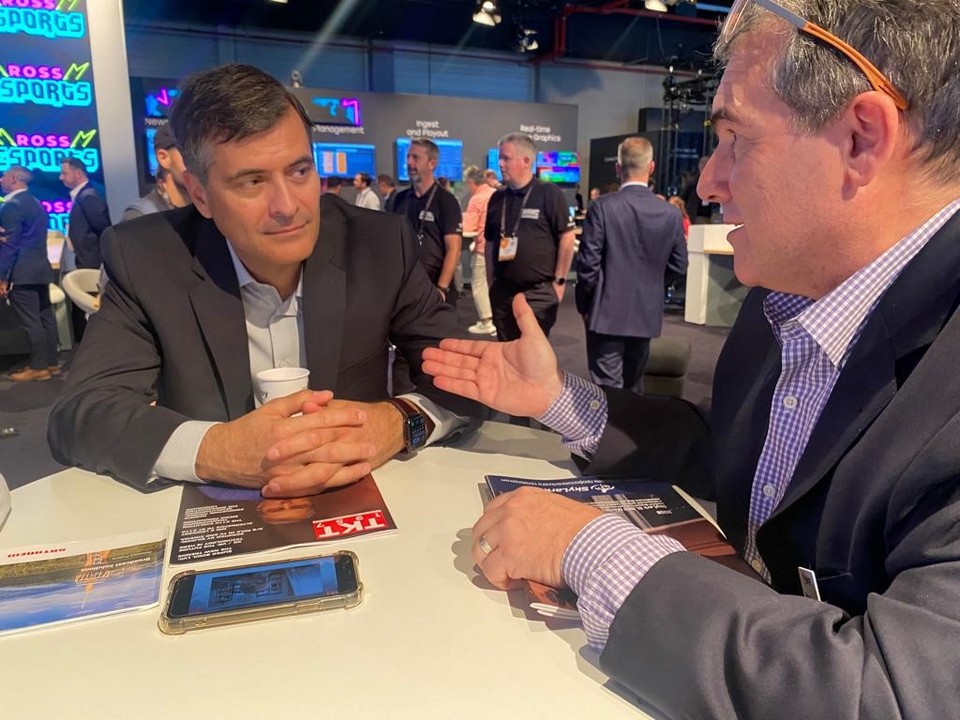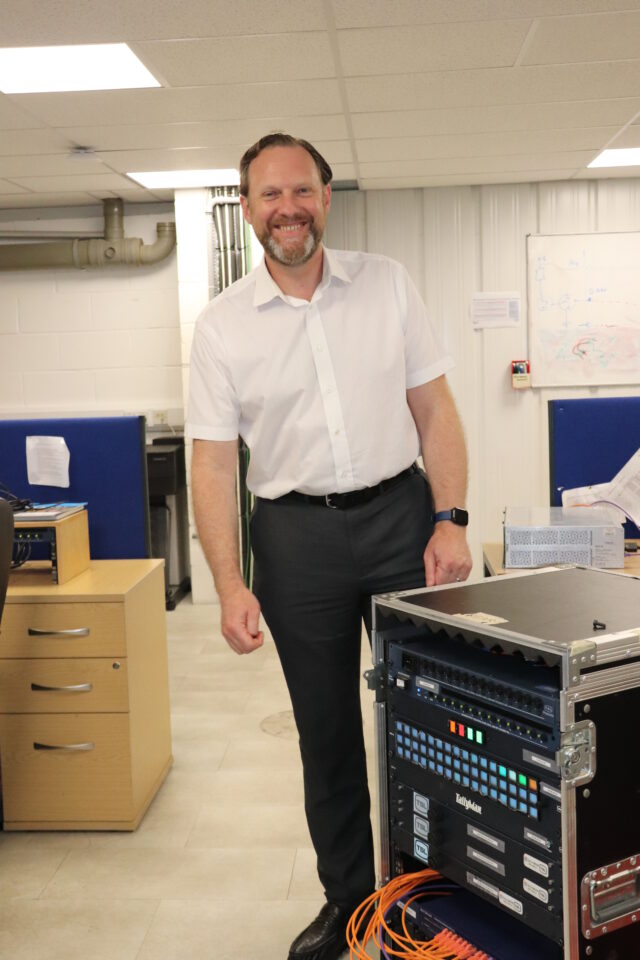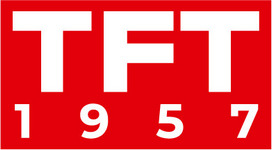 Interview with Oleg Ogloblya, Chief Engineer at Comtel Broadcast Solutions (Kyiv, Ukraine). Published in the March 2025 issue of TFT 1957 (Vol. 3, Issue No. 779 since founding).
Interview with Oleg Ogloblya, Chief Engineer at Comtel Broadcast Solutions (Kyiv, Ukraine). Published in the March 2025 issue of TFT 1957 (Vol. 3, Issue No. 779 since founding).
Comtel’s Historical and Strategic Choice
– Why did you choose to compare these four platforms in particular?
I’ve always found the question “why” difficult to answer. I often joke: “Because I want to — isn’t that enough?”
But seriously, the selection of Evertz, GV, Riedel, and Lawo resulted from an in-depth market analysis by the Comtel team. This is our contribution to the future of the industry.
 The historical context also played a significant role. After the collapse of the USSR, in the early 2000s, global leaders of the time — Sony, Leitch-Harris, Clear-Com, Studer — entered the Ukrainian market. Alongside them came the first Moscow-based system integrators. We invested heavily in research: attending international exhibitions, visiting TV stations in Europe and the USA, and touring manufacturers’ plants.
The historical context also played a significant role. After the collapse of the USSR, in the early 2000s, global leaders of the time — Sony, Leitch-Harris, Clear-Com, Studer — entered the Ukrainian market. Alongside them came the first Moscow-based system integrators. We invested heavily in research: attending international exhibitions, visiting TV stations in Europe and the USA, and touring manufacturers’ plants.
This comprehensive approach is one reason there are still no foreign (including Russian) integrators in Ukraine. This allows us to implement highly innovative and complex projects — despite limited budgets.
 A Technological Turning Point: IP and SMPTE 2110
A Technological Turning Point: IP and SMPTE 2110
– The industry breakthrough occurred in the previous decade…
By 2012–2014, when the first fully functional SMPTE 2110-based solutions emerged, it became clear we had made the right choice. These companies will shape the industry for decades — in both the IP and classic baseband segments.
We watched the market consolidate with interest: Harris sold its broadcast division, which became Imagine Communications; Clear-Com joined HME; RTS and Telex merged; Sony acquired Nevion but cut back on its product range; SoundCraft and Studer joined Harman. Thus, new technological leaders emerged.
 Selection Criteria and Cases of Embrionix and Ross Video
Selection Criteria and Cases of Embrionix and Ross Video
– How do you identify a promising manufacturer?
There are many interesting companies on the market. At Comtel, we developed a simple criterion: if a manufacturer demonstrates a systematic and consistent approach to product development, and their catalog features more than just one or two items, they’re worth partnering with.
A good example is Embrionix:
At NAB, their booth is hard to notice — just a 3×3 m pavilion. However they offered unique SMPTE 2110-based solutions for TV stations. Their arsenal included just three SFP module types — input, output, and CPU modules. That was enough for Embrionix to become part of Riedel Communications.

– A logical move by Thomas Riedel. He bought the company and secured a place on the broadcast monopoly chessboard. And what about David Ross?
The opposite case is Ross Video. A traditional leader in video mixers, OverDrive solutions for news studios, and respectable-grade modules. But in the IP segment, things are less successful in our view. There were attempts to use IP-gateway boards for Acuity, developed in cooperation with Evertz, but they didn’t catch on.
Later, Newt and Iggy’s solutions emerged, but building a full TV channel on them is difficult. Perhaps IP simply isn’t Ross’s focus.

Evertz Scorpion Platform Features
– What advantages does it offer over competitors?
This one’s simple. Scorpion is superior in nearly every way. It’s a next-generation modular infrastructure with universal FPGA processors. The key difference: that module functionality is determined by the software loaded at any given time. You can store several applications and load them as needed.
You buy just one or two MIO module types and gain vast functionality: from SDI↔IP converters to FS, UDX, DSK, logo inserter, and change-over processors. Modules include both external connectors and ports for the internal 12G-SDI and IP bus.
Chassis range from 2 to 36 modules, including integration into NEXX hybrid matrices. Each chassis is essentially both a 12G SDI matrix and an IP router. There are also SFP module slots (10/25/100 Gbps), enabling flexible IP network connections or optical transport.
 – Where is Scorpion most effective?
– Where is Scorpion most effective?
It’s ideal for network processing and remote production. We’ve long stopped using standalone FS or audio embedder/de-embedder modules — they’re now built into the matrix.
– But floating UDX, DSK, and audio processors accessible from any point in the network?
That’s a powerful advantage. Remote production is especially relevant when local network providers are willing to cooperate.
 Cost Comparison: IP vs. SDI
Cost Comparison: IP vs. SDI
– What matters more — cost or functionality?
Cost is the key issue today. IP versions of identical equipment are 1.5–2 times more expensive than SDI. Show an investor the price of an IP video mixer vs. SDI — the project might be scrapped at the first meeting.
But the direct comparison is unfair. A system becomes cost-effective only when most equipment is switched to IP. “Extra” gateways drastically reduce efficiency. That’s why it’s crucial to design systems replacing baseband chains with unified IP components.
 Optimization example: One IP card instead of four modules
Optimization example: One IP card instead of four modules
Patch panel → FS module → audio DMX module → DA amplifier can be replaced with a single gateway generating:
– Two 2110-20 (2022-7) streams.
– Eight stereo 2110-30 streams.
– One 2110-40 metadata stream
A network switch in boundary clock mode provides FS or CS. Platform choice then depends on taste, design, brand familiarity, and other subjective factors. Price-wise, there’s little difference — SDI-IP gateways cost $800–$1,000.
 Hidden Costs: Staff Training and System Controllers
Hidden Costs: Staff Training and System Controllers
– But those aren’t the only expenses.
Any IP system requires staff training — another added cost. The learning curve isn’t steep: just understand *.sdp files and how network switches work. Add $30,000–$50,000 to the budget if you’re using a system controller — like Evertz’s Magnum, Lawo’s VSM, Axon’s Cerebrum, etc. These allow system control via standard panels, reducing staff workload.
Controllers create a division of roles: regular shift engineers and those who tune the system. The broadcaster’s IT department usually isn’t involved.
TFT 1957 (Television & Film Technologies): What’s Next in Tech: NAB & ISE 2025 Highlights
Broadcasting Financial Realities
TV is capital-intensive. If you don’t have the budget, you’ll make do with a Harris Platinum matrix, OpenGear modules, or AJA and BM boxes. You’ll convince yourself and your investor that it’s functional and “good enough.”
Meanwhile… Elon Musk is flying to Mars.
 Platform Scalability and Software Role
Platform Scalability and Software Role
– Which platforms are best for small channels vs. media giants?
Theoretically, every platform has limits. But in post-Soviet regions, few can reach them anytime soon.
Example: Evertz’s NATX switch line:
– NATX-16: 1.6 Tbps (533×533 3G-SDI equivalent).
– NATX-32: 3.2 Tbps (1066×1066).
– NATX-64: 6.4 Tbps (2133×2133).
All fit into 1RU, 19” units. In reality, even 576×576 SDI matrices are rare. So “small channel” now means much bigger numbers.
 – What about the controller’s role in platform choice?
– What about the controller’s role in platform choice?
The smaller the budget, the more important the software. Riedel/Embrionix, for instance, uses the MN-SET system with a VUE interface — a familiar control panel (SRC, DST, TAKE). It’s customizable per operator. Evertz and Lawo also offer routing software, but in our experience, Riedel’s is slightly more user-friendly.
If the core is a 288×288 matrix, you might skip an external controller. But the audio section could be 16 times larger: 4608×4608 mono-equivalent channels. The panel becomes bulky; scrolling is endless. Frame-accurate switching becomes unfeasible.
By the way, Lawo’s .edge 288×288 solution is a standard 6RU kit.
 SDVN, MediorNet, AMPP, and HOME Integration
SDVN, MediorNet, AMPP, and HOME Integration
– How complex is the setup and management? What are the staffing requirements?
Once you’ve worked with different systems, the perceived complexity of the setup feels exaggerated. After an internship at Evertz’s Canadian factory and MAGNUM installation under an engineer’s guidance, the logic becomes clear.
Even TSL’s TallyMan, in its minimal configuration, offers many useful functions. But it all depends on the team. If the engineers are disengaged, a controller is a waste of money. But if their eyes light up — success is inevitable.
IP is slightly more complex due to the number of settings. There’s a big difference between a system where 1 input = 1 signal, and one where signals don’t match physical ports.
For example, in SMPTE 2110 setups, each gateway generates:
– Standard IP — unicast control address.
– 2110-20 — two multicast streams (main and redundant).
– 2110-30 — up to 8 streams of 2 channels each, or one 16-channel stream.
– 2110-40 — metadata stream.
As a result, a system with 2 studios, 15–20 editing suites, a 4–5 channel playout, and an audio route ends up with 25,000–30,000 IP/multicast addresses.
– Which platform offers the full tool stack?
The answer is obvious: only a few companies. Only those producing a full set of devices can ensure compatibility and stability. The main difficulty lies in the “virtuality” of IP. You can’t just plug in a monitor and see a signal. Even if a device responds to a ping, it doesn’t mean there are streams. However, you can monitor the network using standard IT tools that are easy to learn online.
Important: working with *.sdp files is a critical skill
 GV AMPP Stands Apart
GV AMPP Stands Apart
While Lawo HOME offers small services (DSP, DSK, UDX), GV AMPP took a bolder route: virtualizing entire departments — MCR, AVM, multi-channel ingest, playout, commentary, etc. It’s an ambitious idea but raises concerns. When all you have is laptops and internet instead of hardware, you wonder — who gets penalized for an on-air failure?
Ukraine’s Reality: The Cloud Isn’t for Us — Yet
In Ukraine, cloud services are a risk today. Signal loss from cyberattacks or traffic limitations is a real issue. After the war — maybe. For now, only local servers. We evaluated projects with AMPP, but 32–64 HD streams in SRT, NDI, or JPEG-XS raise questions. It’s better to study real systems, not promises.
 The State of the Broadcast Market and Implementation Examples
The State of the Broadcast Market and Implementation Examples
– Any real use cases in Ukraine with Evertz, Riedel, GV, and Lawo?
Nobody openly shares TV channel developments in Ukraine today. Let’s stick to general info: over 720 media companies operate in the country, offering solutions for every taste and budget.
Major Ukrainian media holdings, whose modernization started before the war, use Evertz EQX infrastructure elements. Although, many still run Harris Platinum — “Mr. Pz’s last breath.”
Riedel MediorNet is used, conservatively speaking, by 90% of broadcasters. There are over 250 frames in Ukraine now. It handles most everyday tasks.
 IP infrastructure is being deployed slowly but steadily. When large-scale modernization isn’t feasible, companies start experimenting.
IP infrastructure is being deployed slowly but steadily. When large-scale modernization isn’t feasible, companies start experimenting.
At Comtel, we’ve identified three key IP implementation phases:
- Signal transport infrastructure.
- Autonomous departments and functional nodes.
- Decentralized production (especially relevant during wartime).
Interestingly, only one TV channel closed during Ukraine’s three-year war. In the early months, SRT-based solutions were popular, but after the failed 2024 Olympic broadcast, interest shifted to 2110/2022. Some built remote playout in other cities, others use 10 Gbps MPLS channels. A few optical fibers and 25 Gbps SFP+ modules enable duplex transport of up to 12 HD streams over 80 km.
Ukrainian engineers are no longer afraid of IP infrastructure. OB vans, preview rooms, commentary booths, audio studios — all of this is normal practice now. Solutions using SFP modules built into switches appear cheaper than traditional BM or AJA boxes. A compact, reliable IP solution at a broadcast level is preferable.
What’s Wrong with Blackmagic Design?
 – Why don’t Blackmagic Design solutions meet system integrators’ needs?
– Why don’t Blackmagic Design solutions meet system integrators’ needs?
In a poor country, Blackmagic’s model looked promising — even dangerous. At first, it seemed like “This is it! TV will run on BM!” But then we realized — it’s not that simple.
We began comparing equivalent configurations. Not “apples to oranges,” but “same to same.”
Example: one MicroN-3G module with a P2P license from Riedel provides:
– Video matrix: 24×24 3G-SDI.
– Audio matrix: 640×640 mono.
– Frame sync: 24 inputs.
– Video delay: 24x.
– Audio embedder/de-embedder: 24x, with 16 channels each.
– MADI converters (bi-directional).
– Fiber link: 26 Rx / 26 Tx.
Replicating this with BM gear, plus cables, connectors, and mounting — yields no savings. It takes up more rack space, is less convenient, and lacks centralized control.
That’s what’s wrong with Blackmagic.
 The Future of SDVN and IP Technologies in Media Production
The Future of SDVN and IP Technologies in Media Production
– How will the market evolve? Which platforms are promising?
Our forecast, confirmed over the past 10 years: IP infrastructure is now a self-sufficient direction alongside SDI.
That Russian company’s IBC slogan “SDI must die” didn’t come true. Even market leaders are still cautious about IP.
 IP isn’t “better” or “worse”
IP isn’t “better” or “worse”
It’s just “different.” Within the IP segment, two conditional camps have emerged.
HW platforms (hardware-based solutions):
Includes Evertz, Riedel, Axon, and Nevion — companies making their own hardware or OEM components.
SW platforms (process virtualization). Examples:
Lawo (HOME), GV (AMPP), and playout automation. Less hardware diversity, and more emphasis on servers and software.
 This split is fluid. For instance:
This split is fluid. For instance:
– Lawo offers the .edge hardware platform.
– Evertz has dozens of virtual services.
Comtel’s Conclusion: In the long term, no platform holds an absolute advantage
A complete infrastructure upgrade in 10–15 years costs about the same across platforms.
The myth that software is easier to scale and update — is a marketing gimmick. Computers age faster than pro gear, and “hot” software updates are no easy feat.
The main thing is aligning technologies with real tasks and capabilities.
 Manufacturer Support and Service Levels
Manufacturer Support and Service Levels
– What do Evertz, Riedel, GV, and Lawo offer?
Typically, IP system support is mandatory and comprehensive. You can’t buy a project solution without training at the factory. Training is mandatory for technical department heads and shift engineers.
Exceptions are selective deliveries through authorized dealers with the proper skills (Like Comtel).
“The best service is not needing support at all.”
– Evertz MAGNUM under Linux ran for 12 years without a reboot.
– Lawo VSM under Windows — 8 years with no crashes.
(They eventually bought new servers and kept them as cold spares)

Firmware updates were rare — mostly to address non-compliance by third-party vendors with SMPTE or ITU standards.
An example of user responsiveness: initially lacked a De-esser effect — users asked, it was added in the next update.
These small details define a manufacturer’s level.

Additional Capabilities and Cloud Technologies
– How are platforms expanding? Any cloud or MAM integrations?
In IP environments, compatibility is the top enabler.
Just as there aren’t “different SDIs” from Sony or Panasonic, there can’t be “different SMPTE-2110s” from different vendors.
Important note:
NDI and Dante are proprietary protocols. Until NDI becomes SMPTE and Dante becomes AES, they can’t be considered foundational.
Comtel’s key mission is verifying cross-vendor compatibility. We’re confident we offer truly compatible solutions. The cloud is a trendy but expensive tool. Especially in broadcasting, where legally, a virtual product can’t be capitalized.
Who even buys licensed Word or OneDrive? Now imagine a six-figure cloud investment.
As one CTO said:
“The cloud is a $100 bill shredding service.”
Yes, it offers new functions and remote access. But under cyber threats — it’s a risk. As they say, “admin: admin” credentials are still a thing.
Still…
Many manufacturers now limit cloud services, offering only specialized ones (e.g., Lawo or GV hosting MAM in their cloud).
In this case — the manufacturer is responsible for performance.


 Interview with Oleg Ogloblya, Chief Engineer at Comtel Broadcast Solutions (Kyiv, Ukraine). Published in the March 2025 issue of
Interview with Oleg Ogloblya, Chief Engineer at Comtel Broadcast Solutions (Kyiv, Ukraine). Published in the March 2025 issue of  A Technological Turning Point: IP and SMPTE 2110
A Technological Turning Point: IP and SMPTE 2110 Selection Criteria and Cases of Embrionix and Ross Video
Selection Criteria and Cases of Embrionix and Ross Video – Where is Scorpion most effective?
– Where is Scorpion most effective? Cost Comparison: IP vs. SDI
Cost Comparison: IP vs. SDI Optimization example: One IP card instead of four modules
Optimization example: One IP card instead of four modules Hidden Costs: Staff Training and System Controllers
Hidden Costs: Staff Training and System Controllers Platform Scalability and Software Role
Platform Scalability and Software Role – What about the controller’s role in platform choice?
– What about the controller’s role in platform choice? SDVN, MediorNet, AMPP, and HOME Integration
SDVN, MediorNet, AMPP, and HOME Integration GV AMPP Stands Apart
GV AMPP Stands Apart The State of the Broadcast Market and Implementation Examples
The State of the Broadcast Market and Implementation Examples – Why don’t Blackmagic Design solutions meet system integrators’ needs?
– Why don’t Blackmagic Design solutions meet system integrators’ needs? The Future of SDVN and IP Technologies in Media Production
The Future of SDVN and IP Technologies in Media Production IP isn’t “better” or “worse”
IP isn’t “better” or “worse” This split is fluid. For instance:
This split is fluid. For instance: Manufacturer Support and Service Levels
Manufacturer Support and Service Levels






